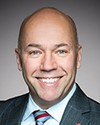Thank you, Dr. Connors.
The next question is from Mike Bossio, please.
Evidence of meeting #29 for Indigenous and Northern Affairs in the 42nd Parliament, 1st session. (The original version is on Parliament’s site, as are the minutes.) The winning word was young.
A video is available from Parliament.
October 19th, 2016 / 4:15 p.m.
Liberal

The Chair Liberal Andy Fillmore
Thank you, Dr. Connors.
The next question is from Mike Bossio, please.
Liberal

Mike Bossio Liberal Hastings—Lennox and Addington, ON
Thank you, Chair.
Thank you, guests, for being here today and providing this valuable information. I apologize to you up front because I have a number of questions and I want to try to get through them. If I cut you off, I'm really sorry, but I want to try to get through them.
Can you tell me what per cent of the Mental Health Commission are indigenous members?
President and Chief Executive Officer, Mental Health Commission of Canada
Do you mean on staff?
President and Chief Executive Officer, Mental Health Commission of Canada
We have increased our numbers just recently. We're trying to get representation in each of our program areas. Currently I believe we have about four indigenous people on staff.
President and Chief Executive Officer, Mental Health Commission of Canada
We have two indigenous board members.
President and Chief Executive Officer, Mental Health Commission of Canada
The board is currently 14.
Liberal

Mike Bossio Liberal Hastings—Lennox and Addington, ON
You're on the Canadian Association for Suicide Prevention. How many indigenous members are part of it?
Director, Canadian Association for Suicide Prevention
We currently have four.
Director and Survivors Chair, Canadian Association for Suicide Prevention
We're on a board of 15.
Director, Canadian Association for Suicide Prevention
There are 15 on the board.
Liberal
Director and Survivors Chair, Canadian Association for Suicide Prevention
Not that I'm aware of. One of the challenges that we had was finding appropriate services for the community in Attawapiskat that were able to connect with the native youth crisis line that operates out of B.C. They have a 1-800 toll-free line, and that was the resource that we were able to offer that was specific to native youth crisis.
Liberal

Mike Bossio Liberal Hastings—Lennox and Addington, ON
Right now you have no direct federal funding for your program. Are you aware of any federal funding program or provincial funding program that goes toward any of these mental health-related programs?
Director, Canadian Association for Suicide Prevention
There are. I couldn't name them all off to you at this point, but there are programs that are—are you asking specifically about indigenous—
Liberal

Mike Bossio Liberal Hastings—Lennox and Addington, ON
Yes. Yes, sorry. Specifically indigenous, yes.
Director, Canadian Association for Suicide Prevention
For mental health, the ones that I'm familiar with are ones that I consult with currently. There are programs like the Enaahtig Healing Lodge and Learning Centre, which is in the Simcoe Muskoka region. It's a fairly large organization. It has funding from the province as well as federally.
Organizations like that exist throughout the country.
Liberal

Mike Bossio Liberal Hastings—Lennox and Addington, ON
We had some organizations come and speak to us. But, once again, the funding model is precarious at best. Here one day, gone the next. One-year program, five-year program.... There's really no long-term stable funding that has been dedicated to this area.
Would you agree with that?
Director, Canadian Association for Suicide Prevention
Yes.
I'm also a board member for the First Peoples Wellness Circle, which used to be referred to as the Native Mental Health Association of Canada. We did have some support from federal funding at one point, and then it was taken away.
And then, I also consult with the Thunderbird Partnership Foundation, which used to be NNAPF. It receives federal funding.
Liberal

Mike Bossio Liberal Hastings—Lennox and Addington, ON
Are there any programs that provide training for indigenous peoples? And once again, is it just a very precariously funded program? Are there any training institutions specifically for indigenous mental health workers, social workers, or nurses?
Director and Survivors Chair, Canadian Association for Suicide Prevention
The Mental Health Commission of Canada has indigenous versions of mental health first aid. So, that would be the first that comes to mind. LivingWorks offers both safeTALK and ASIST, which is applied suicide intervention skills training. They're working on adaptations of that model as well.
There's a suicide prevention program that's tailored and developed by first nations communities that operates out of the Centre for Suicide Prevention in Calgary, and it's called the River of Life.
The training is available, but it is expensive and requires someone on the ground to implement it.
Liberal

Mike Bossio Liberal Hastings—Lennox and Addington, ON
Most of the witnesses we've heard so far have all pointed to the issue around long-term stable funding for many of these programs, that it just doesn't exist. I see heads shaking, so I assume that you all agree with that, the underfunding of those programs.
There are two very quick questions, and I'm running out of time.
The Canadian Indigenous Nurses Association were here earlier this week. They pointed to the fact that we should be, from an education standpoint, starting at grades 3 and 4 to move indigenous students in the direction toward social, mental health, nursing, and medical areas.
Would you also agree with that statement?